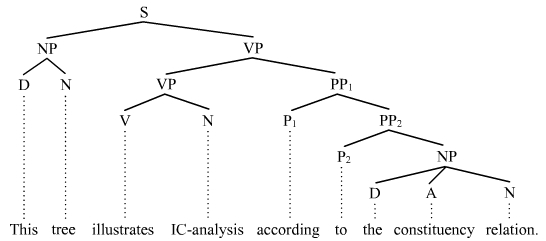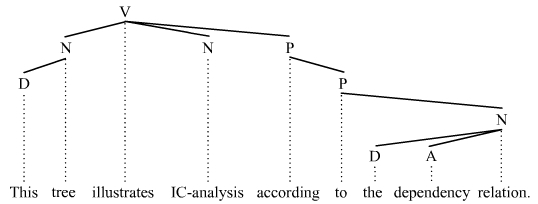
- •1.The subject of theoretical grammar and its difference from practical grammar.
- •17.The category of correlation
- •18. The category of voice
- •19.The category of mood and modality
- •21. The simple sentence
- •25. Immediate constituents syntactic analysis
- •26.Semi-predicative constructions
- •27. Communicative types of sentence. The problem of exclamatory sentence
- •28.Determiners and quantifiers
- •29. Causative forms
- •30. Phrasal verbs as a linguistic problem
- •31. The object as a syntactic category
- •32. The category of assessment(value judgments)
25. Immediate constituents syntactic analysis
In linguistics, immediate constituent analysis or IC analysis is a method of sentence analysis that was first mentioned by Leonard Bloomfield[1] and developed further by Rulon Wells.[2] The process reached a full blown strategy for analyzing sentence structure in the early works of Noam Chomsky.[3] The practice is now widespread. Most tree structures employed to represent the syntactic structure of sentences are products of some form of IC-analysis. The process and result of IC-analysis can, however, vary greatly based upon whether one chooses the constituency relation of phrase structure grammars (= constituency grammars) or the dependency relation of dependency grammars as the underlying principle that organizes constituents into hierarchical structures. Given a phrase structure grammar (= constituency grammar), IC-analysis divides up a sentence into major parts or immediate constituents, and these constituents are in turn divided into further immediate constituents.[4] The process continues until irreducible constituents are reached, i.e., until each constituent consists of only a word or a meaningful part of a word. The end result of IC-analysis is often presented in a visual diagrammatic form that reveals the hierarchical immediate constituent structure of the sentence at hand. These diagrams are usually trees. For example:
 This
tree illustrates the manner in which the entire sentences is divided
first into the two immediate constituents this tree and illustrates
IC-analysis according to the constituency relation; these two
constituents are further divided into the immediate constituents this
and tree, and illustrates IC-analysis and according to the
constituency relation; and so on.An important aspect of IC-analysis
in phrase structure grammars is that each individual word is a
constituent by definition. The process of IC-analysis always ends
when the smallest constituents are reached, which are often words
(although the analysis can also be extended into the words to
acknowledge the manner in which words are structured). The process
is, however, much different in dependency grammars, since many
individual words do not end up as constituents in dependency
grammars.
This
tree illustrates the manner in which the entire sentences is divided
first into the two immediate constituents this tree and illustrates
IC-analysis according to the constituency relation; these two
constituents are further divided into the immediate constituents this
and tree, and illustrates IC-analysis and according to the
constituency relation; and so on.An important aspect of IC-analysis
in phrase structure grammars is that each individual word is a
constituent by definition. The process of IC-analysis always ends
when the smallest constituents are reached, which are often words
(although the analysis can also be extended into the words to
acknowledge the manner in which words are structured). The process
is, however, much different in dependency grammars, since many
individual words do not end up as constituents in dependency
grammars.
IC-analysis in dependency grammars .IC-analysis is much different in dependency grammars.[5] Since dependency grammars view the finite verb as the root of all sentence structure, they cannot and do not acknowledge the initial binary subject-predicate division of the clause associated with phrase structure grammars. What this means for the general understanding of constituent structure is that dependency grammars do not acknowledge a finite verb phrase (VP) constituent and many individual words also do not qualify as constituents, which means in turn that they will not show up as constituents in the IC-analysis. Thus in the example sentence This tree illustrates IC-analysis according to the dependency relation, many of the phrase structure grammar constituents do not qualify as dependency grammar constituents:
 This
IC-analysis does not view the finite verb phrase illustrates
IC-analysis according to the dependency relation nor the individual
words tree, illustrates, according, to, and relation as
constituents.While the structures that IC-analysis identifies for
dependency and constituency grammars differ in significant ways, as
the two trees just produced illustrate, both views of sentence
structure are acknowledging constituents. The constituent is defined
in a theory-neutral manner:ConstituentA given word/node plus all the
words/nodes that that word/node dominates.This definition is neutral
with respect to the dependency vs. constituency distinction. It
allows one to compare the IC-analyses across the two types of
structure. A constituent is always a complete tree or a complete
subtree of a tree, regardless of whether the tree at hand is a
constituency or a dependency tree.
This
IC-analysis does not view the finite verb phrase illustrates
IC-analysis according to the dependency relation nor the individual
words tree, illustrates, according, to, and relation as
constituents.While the structures that IC-analysis identifies for
dependency and constituency grammars differ in significant ways, as
the two trees just produced illustrate, both views of sentence
structure are acknowledging constituents. The constituent is defined
in a theory-neutral manner:ConstituentA given word/node plus all the
words/nodes that that word/node dominates.This definition is neutral
with respect to the dependency vs. constituency distinction. It
allows one to compare the IC-analyses across the two types of
structure. A constituent is always a complete tree or a complete
subtree of a tree, regardless of whether the tree at hand is a
constituency or a dependency tree.
